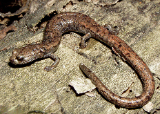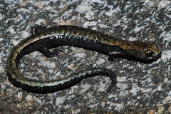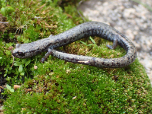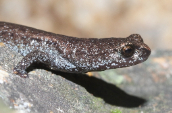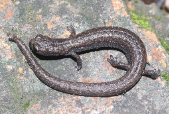 |
Tehachapi Slender Salamander Range Map
|
|
|
 |
 |
 |
 |
 |
 |
 |
Tehachapi Slender Salamander Juvenile
Want to Contribute a photo of a Juvenile Tehachapi Slender Salamander?
Email Us
|
|
|
 |
 |
 |
 |
 |
 |
|
Tehachapi Slender Salamander (Batrachoseps stebbinsi)
Description: Adults are 2 to 2 2/5 inches long from snout to vent, 3.5 to 5 inches in total length. A small slim salamander, with 18 to 19 costal grooves.
Short limbs, a narrow head, long slender body, very long tail, and conspicuous costal and caudal grooves give this species the worm-like appearance typical of most Slender Salamanders. Relatively large and robust when compared with most Slender Salamanders, having a fairly broad head, long legs, broad feet, shorter tail, and toes that appear to be slightly more webbed than with other Batrachoseps species. There are four toes on the front and hind feet, which is also typical of Slender Salamanders. (Other California salamanders have five toes on the hind feet.) Color is reddish or brownish. Light beige, tan, black, patches and blotches may form an indistinct dorsal stripe with uneven edges.
Habitat: It lives in damp leaf litter and emerges during high humidity or rain.
Range: The Tehachapi slender salamander is found only in isolated areas of the Piute and Tehachapi Mountains of the Transverse Ranges in Southern California. Much of the salamander's habitat is currently located on land owned by Tejon Ranch.
Found in these States:
CA
Diet: Eats a variety of small invertebrates. Feeding behavior is not well known, but other Batrachoseps species are sit-and-wait predators that use a projectile tongue to catch prey.
Reproduction: Little is known about the breeding behavior of this species. Reproduction is terrestrial. Breeding and egg-laying probably occurs during the unpredictable rainy period which can occur anywhere from from November to February. Possibly gravid females have been discovered in mid Februrary and early April. All species of Slender Salamanders lay eggs, typically in moist places on land. Young develop completely in the egg and hatch fully formed. Juvenile salamanders are rarely found, suggesting that they hatch underground at the end of the wet season and remain underground during the beginning of their lives.
Status: Listed as Endangered because its extent of occurrence (EOO) is 2,631 km2, it occurs in two threat-defined locations, and there is continuing decline in the extent and quality of its habitat due to housing and urban development, road construction, mining, logging, cattle grazing, and the development of flood-control projects.
»» Kingdom: Animalia - Animals
»» Phylum: Chordata - Chordates
»» Subphylum: Vertebrata - Vertebrates
»» Class: Amphibia - (Amphibians)
»» Order: Caudata - Salamanders
»» Family: Plethodontidae - Lungless Salamanders
»» Genus: Batrachoseps
»» Species: Batrachoseps stebbinsi - Tehachapi Slender Salamander
This article uses material from the Wikipedia article "Tehachapi Slender Salamander", which is released under the Creative Commons Attribution-Share-Alike License 3.0. Content may have been omitted from the original, but no content has been changed or extended.
|
|




